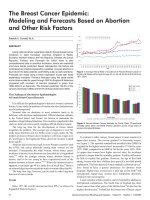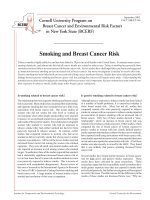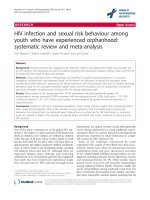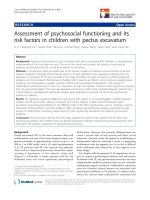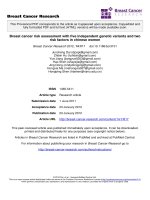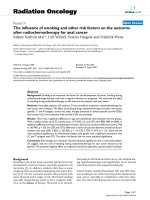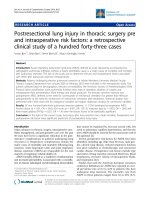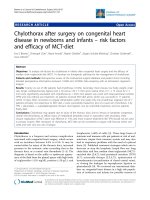Bacterial profile, antimicrobial susceptibility pattern and associated risk factors among septicemia suspected pediatrics patients at zewuditu memorial hospital, addis ababa, ethiopia
Bạn đang xem bản rút gọn của tài liệu. Xem và tải ngay bản đầy đủ của tài liệu tại đây (671.43 KB, 79 trang )
ADDIS ABABA UNIVERSITY
COLLEGE OF HEALTH SCIENCE
DEPARTMENT OF MEDICAL LABORATORY SCIENCE
Bacterial profile, antimicrobial susceptibility pattern and associated risk
factors among septicemia suspected pediatrics patients at Zewuditu Memorial
Hospital, Addis Ababa, Ethiopia
A thesis submitted to department of Medical Laboratory Science, College of Health
Science, Addis Ababa University in partial fulfillment of the requirements for the degree of
masters in Clinical Laboratory Sciences (Diagnostic and Public Health Microbiology
specialty)
By-Daniel Tsega (BSC)
Advisors: - Kassu Desta (PhD Fellow)
-Dr.Yohannes Woldekidan (MD, MSc)
June, 2017
Addis Ababa, Ethiopia
Project Submission form
Name of the principal
Investigator
Daniel Tsega
Email:
Cell phone: 0913-308205
Full title of the research
Bacteriological profile, antimicrobial susceptibility pattern
and associated risk factor of pediatrics septicemia at ZMH,
Addis Ababa, Ethiopia.
Duration of the project
June 5, 2016 to March 8, 2017
Study Area
Zewuditu Memorial Hospital
Total Cost of the project
40,007 (Et. birr)
Source(s) of Funding
AAU, AAPHREMCP and Self financing
Name of Advisor(s)
Mr. Kassu Desta (PhD fellow)
Cell phone:0911107099
Department of Medical Laboratory Science, AAU
Dr. Yohannes Woldekidan (MD, MSC)
Cell phone:0911384599
Senior researcher, AAPHREMCP
I
Acknowledgment
I would like to acknowledge Addis Ababa University, Collage of Health science, School of
Allied Health Science, Department of Medical Laboratory Sciences for their financial support.
Addis Ababa Public health research and emergency management core process for their material
and technical support and Zewuditu Memorial Hospital pediatrics ward for their support in data
collection.
My special thanks & gratitude goes to my Advisors, Mr Kassu Desta (PhD fellow) and
Dr.Yohanes Woldekidan for giving me constructive ideas and feed backs in the preparation of
this research paper.
I also thanks to Addis Ababa Public health research and emergency management core process
microbiology department staff Mis Semira Ibrahim (BSc,MSc), Mr. Dawit Desta (BSc) and Mr
Gebeyawu Zeleke (BSc, MSc), for their valuable contribution in the data collection, data analysis
and write up of the paper.
My heartfelt regards to all the parents and guardians of thepediatrics who participated in this
study for their contribution in improving pediatrics health and also for making this study
possible.
Finally, I am so thankful to ZMH laboratory head and staffs who support me to do some tests in
their laboratory and for their willingness to cooperate with the study.
II
Table of Contents
Pages
Acknowledgment ............................................................................................................................ II
List of Tables ................................................................................................................................. V
List of figures ................................................................................................................................ VI
List of abbreviation ...................................................................................................................... VII
Operational definitions............................................................................................................... VIII
Abstract ......................................................................................................................................... IX
1. Introduction ................................................................................................................................. 1
1.1 Background ........................................................................................................................... 1
1.2. Statement of the problem ..................................................................................................... 3
1.3. Significance of the study ...................................................................................................... 5
2. Literature review ......................................................................................................................... 6
2.1 Septicemia ............................................................................................................................. 6
2.2 Risk factors ............................................................................................................................... 9
2.3 AST Pattern ......................................................................................................................... 10
3. Objectives ................................................................................................................................. 12
3.1. General objectives .............................................................................................................. 12
3.2. Specific objectives.............................................................................................................. 12
4. Hypothesis................................................................................................................................. 13
5. Materials and methods ............................................................................................................. 14
5.1. Study area ........................................................................................................................... 14
5.2. Study design and study period ........................................................................................... 14
5.3. Population........................................................................................................................... 14
5.3.1 Source Population ......................................................................................................... 14
5.3.2. Study population .......................................................................................................... 14
5.4. Variables of the Study ........................................................................................................ 14
5.4.1Independent variables .................................................................................................... 14
5.4.2 Dependant variables: .................................................................................................... 14
5.5. Inclusion and exclusion criteria.......................................................................................... 15
5.6 .Sample size determination and Sampling .......................................................................... 15
5.6.1. Sample size determination ........................................................................................... 15
III
5.6.2. Sampling procedures ................................................................................................... 15
5.7. Data collection procedures ................................................................................................. 15
5.7.1. Demographic characteristics and exposure to risk factors .......................................... 15
5.7.2. Specimen collection and transportation....................................................................... 16
5.7.3. Specimen Processing ................................................................................................... 16
5.8 Data management and Quality control ................................................................................ 17
5.8.1. Pre-analytical phase ..................................................................................................... 17
5.8.2. Analytical phase .......................................................................................................... 18
5.8.3. Post-analytical phase ................................................................................................... 18
5.10. Ethical consideration ........................................................................................................ 20
6. Results ....................................................................................................................................... 21
6.1Socio-demographic characteristics ....................................................................................... 21
6.2 Predictor of positive blood culture ...................................................................................... 27
6.3 Bacterial profile of septicemic pediatrics ............................................................................ 29
6.4 Antibiotic resistance pattern of theisolates.......................................................................... 31
7. Discussion ................................................................................................................................. 34
8. Limitation .................................................................................................................................. 40
9. Conclusion ................................................................................................................................ 41
10. Recommendation .................................................................................................................... 42
11. References ............................................................................................................................... 43
Annexes......................................................................................................................................... 47
Annex 1: English version of participant information sheet, assent, consent & questionnaire .. 47
Annex 2: Procedure for specimen collection, processing and result interpretation .................. 54
Annex 3: Amharic version of participant information sheet, assent, consent&questionnaire .. 62
Declaration .................................................................................................................................... 68
IV
List of Tables
Table 1.Cross tabulation of monthly income per individual and number of sisters and/or
brothers with age group in sex of septicemia suspected ……………………………………….21
Table 2.Cross tabulation of gestational age and birth weight with sex in age group …………..21
Table 3.Clinical feature of septicemia and positive blood culture.... ……………………….....23
Table 4. Socio-demographic characteristics and back ground information with septicemia ….24
Table 5. Risk factors and CBC parameter result with septicemia…………………………......26
Table 6. Multivariable regression analyses of predictors of septicemia……………………….28
Table 7.Distribution of isolated organism in sex, age and ward of septicemia suspected
pediatrics………………………………………………………………………………………..30
Table 8. Multi drug resistance (MDR) level of the bacterial isolate from blood among
septicemia suspected pediatrics………………………………………………………………...31
Table 9. Antimicrobial resistance levels of bacterial isolates from blood among septicemia
suspected pediatrics …………………………………………………………………………….33
V
List of figures
Figure 1Work flow of the study………………………………………………………………....19
Figure 2 Bar graph showing frequency of clinical features seen in septicemia suspected
pediatrics…………………………………………………………………………………………22
Figure 3 List of indwelling medical device in septicemia suspected
pediatrics…………………………………………………………………………………………25
VI
List of abbreviation
AAPHREMCP: Addis Ababa Public Health Research & Emergency Management Core Process
AAU:
Addis Ababa University
AOR:
Adjusted Odds Ratio
ART:
Anti-Retroviral Therapy
BF:
Blood Film
BSI:
Blood Stream Infection
CBC:
Complete Blood Count
CI:
Confidence Interval
CLSI:
Clinical and Laboratory Standards Institute
CONs:
Coagulase Negative Staphylococci
DST:
Drug Susceptible Test
EOS:
Early Onset of Sepsis
HIV:
Human Immune Deficiency Virus
IPD:
Inpatient Department
LBW:
Low Birth Wight
LOS:
Late Onset of Sepsis
MDR:
Multi Drug Resistance
MMC:
Myelomeningocele
NICU:
Neonatal Intensive Care Unit
OPD:
Outpatient Department
COR:
Crud Odds Ratio
SPSS:
Statistical Package for Social Sciences
SOP:
Standard Operational Procedures
TSB:
Trypto Soya Broth
WHO:
World Health Organization
ZMH:
Zewuditu Memorial Hospital
VII
Operational definitions
Sensitivity (S): Zone of inhibition radius is wider than, equal to, or not more than 3mm smaller
than the control.
Intermediate (I): Zone of inhibition radius is more than 3mm smaller than the control but not
less than 3mm.
Resistant (R): No zone of inhibition or zone radius measure 2mm or less than the control.
Septicemia: -defined as the presence of bacteria in the blood/bacterial blood stream infection.
Nosocomial infection: -refers to hospital acquired infection which is occurring within 48 hours
or more after admission.
Community acquired infection: - refers to an infection acquired in the community which is
occurring 48 hours or more before admission.
Multi Drug Resistance: - bacterial resistance for three or more antibiotics.
VIII
Abstract
Introduction: Septicemia defined as the presence of bacteria in the blood and is often associated
with severe infections. It causes great impact in terms of mortality, morbidity and increased in
healthcare cost. There are many risk factors of septicemia among different patient groups.
Objectives: The study was designed to assess bacterial profile, antibiotic susceptibility pattern
and associated risk factor of pediatrics septicemia at Zewuditu Memorial Hospital, Addis Ababa,
Ethiopia.
Methods: A hospital based cross sectional study design; conducted at Zewuditu Memorial
Hospital from June 5, 2016 to March 8, 2017.A total of 309 study participants who were suspected
for septicemia recruited .Socio-demographic and clinical data were collected from each patient.
Blood was drawn aseptically and inoculated at bedside on Trypto Soya Broth. Gram stain was
performed and the specimen was sub cultured every other day on to blood agar, chocolate agar
and MacConkey agar plates. For culture positive; colony characteristics and Biochemical tests
used for species identification. All the isolatestested for susceptibility by using Kirby-Bauer’s
disk diffusion method. All data entered to EPIINFO version 3.5.1 and then exported to SPSS
statistical software version 20 for data analysis. Multiple Logistic regression analysis was used to
see the association between dependent and independent variables.
Results: Out of 309 samples, 113(36.5%) showed bacterial growth, 84(74.3%) gram positive and
29(25.3%) gram negative bacteria. Commonly isolated organisms were Staphylococcus aureus
57(50.4%),Coagulase negative Staphylococci25(22%) and Klebsiellapneumoniae21(18.5%).
Birth weight, underlying chronic disease, congenital anomalies, neutrophil percentage, source of
infection and age of the pediatrics were associated with positive blood culture. Both Gram
positive and negative bacteria showed resistance for commonly prescribed antibiotics.
Clindamycin was the most effective antibiotic for gram positive bacteria while for gram negative
bacteria cefotetan and ceftraxion were effective drugs for gram negative bacteria.
Conclusion: The pattern of organism that cause pediatrics septicemia changes over time and in
geographical location. High prevalence of antimicrobial resistance was noted in this study,
especially in gram negative bacteria. Moreover multi-drug resistance of the isolate was
surprisingly high (89.3%).
Keyword: septicemia, bacteriological profile, antimicrobial susceptibility pattern, blood culture
IX
1. Introduction
1.1 Background
Septicemia is defined as the presence of bacteria in the blood and is often associated with severe
infections, the alternative names (Blood poisoning, Bacteremia with sepsis, systemic
inflammatory response syndrome) [1].Pediatrics with septicemia present with poor activity, fever,
vomiting, chills, difficulty in breathing, tachycardia, malaise, refusal of feeds or lethargy
hypothermia, respiratory distress, abdominal distension, jaundice, toxicity and eventually the
extreme form being-shock [2]. Blood stream infections range from self-limiting infections to life
threatening sepsis that requires rapid and aggressive antimicrobial treatment [3]. It is a common
condition in children with a resultant of high morbidity and mortality [4, 5].
Varieties of bacteria have been found to cause blood stream infection in children. These
includes; Staphylococcus
spp, Streptococcus spp,
Enterobacter spp, E.coli, Pseudomonas spp,
Klebsiella pneumoniae, , Enterococcus spp, Neisseria meningitides, Salmonella spp, Moraxella
catarrhalis,and Haemophilus influenzae [6, 7].
Bacteriological culture to isolate the etiologic agent and knowledge about sensitivity pattern of
the isolates remain the main stay of definitive diagnosis and management of BSI [8].Early
treatment with antibiotics is possible with the help of certain indirect markers such as neutropenia
(<1800 cells/mm3), leucopenia (<5000 cells/mm3), band cells, micro ESR and C-reactive protein
(CRP). All these investigations are collectively known as sepsis screen and aids in early diagnosis
of neonatal sepsis in the absence of negative blood cultures [9].
The choice of antibiotic therapy is best guided by the knowledge of etiologic agent. This,
however, is usually notimmediately possible. Thus, it is customary to initiate treatment with an
empirical choice of antibiotic(s) that is informed by the epidemiology of causative agents and
sensitivity patterns in a given locality [10].
Several risk factors have been identified both in the neonates and children, which make them
susceptible to infectionswhich points to the need for bacteriological monitoring in the pediatric
wards. In neonates there are early onset of sepsis (EOS) which is usually related to peripartum
factors i.e. acquisition of the infectious agent during or after delivery and late onset sepsis(LOS)
1
is usually acquired in the newborn nursery, neonatal intensive care unit or in the
community[11,12,13]. The risk factors for neonatal septicemia include premature rupture of
membrane, prolonged rupture, prematurity, Urinary Tract Infection, poor maternal nutrition, low
birth weight, birth asphyxia and congenital anomalies [14]. The risks of children septicemia
include; serious injury, chronic antibacterial therapy, malnourishment, chronic medical problems,
and immunosuppressant drug therapy. Polymicrobial sepsis occurs in high risk patients and is
associated with catheters, changing pattern of antimicrobial usage, gastrointestinal diseases,
neutropenia, malignancy, overstay in intensive care units, increased use of steroids and
immunomodulators, and human immunodeficiency virus (HIV) infections [15].
2
1.2. Statement of the problem
Blood stream infection (BSI) remains one of the most important causes of morbidity and
mortality throughout the world [16]. The mortality rate due to bacteremia ranging from 20-50%
worldwide [17].The World Health Organization (WHO) estimates that 85% of newborn deaths
are due to infections including sepsis, pneumonia and tetanus. Worldwide, 76% (4.6 million) of
the under five deaths occur due to undiagnosed invasive bacterial infections. Moreover, bacterial
culture to diagnose bacterial infection is not routinely done in most of the primary and secondary
health facilities and these made the problem more complicated in developing countries [18].
In 2000-2003 report, the world health organization estimated that neonatal sepsis and pneumonia
are responsible for about 1.6 million deaths each year, mainly in developing countries. Rates of
hospital –acquired neonatal infections 3-20 times higher in developing than developed countries.
Culture-proven neonatal sepsis is associated with increased mortality rates, morbidity and
prolonged hospital stays, both the human and fiscal costs of this disease are high [19]. On the
other handamong infants identified with sepsis, 40% die and the biggest toll being in developing
countries. Also neonatal septicemia continues to be a major health problem with up to 323 of
every 1000 neonates seen in clinics presenting with clinical symptoms [20]. It is estimated that up
to 20% of neonates develop sepsis and approximately 1% die of sepsis related causes [21].In US,
out of 17,136,365 children (19 years old or less) and 899,000 live births in the seven states, the
annual incidence of
BSI was 0.56 /1,000 children or 42,364 cases per year. The incidence was
highest in infants (5.16 /1,000) and fell dramatically in older children (0.2/1,000) [22].
Common etiologic agent for pediatrics blood stream infection (BSI) has been identified in
developed country(Europe and USA) as S. aureus and E.coli. Whereas, in developing country like
in sub-Saharan Africa, S.aureus, Klebsiella spp and Salmonella spp are the commonest etiologic
agent of pediatrics blood stream infection [23].
The epidemiology of pediatric bloodstream infection (BSI) in Africa is poorly documented.
Despite there are few published descriptions of community-acquired sepsis in African children,
data on hospital-acquired BSI are extremely limited. It is estimated that healthcare-associated BSI
may be responsible for 25000 deaths in African children annually. Overall, incidences rates of
healthcare-associated infection in developing countries are thought to be at least double that of
3
high-income settings [24].Septicemia remains the leading cause of morbidity and mortality
among children less than5 years of age in sub-Saharan Africa.Its definitive diagnosis depends on
the blood culture positivity, but in most cases only 50% of all positive blood culture represents
true blood stream infection [25].One in every six African children dies before the age of five
years. The World Health Organization (WHO) rank the major causes of mortality in African
children younger than five years as neonatal causes among which the entity "sepsis" contributes a
quarter(26%), pneumonia (21%), malaria (18%) diarrhea (16%) and HIV-infection (6%) [6].
One of the more alarming recent trends in infectious diseases is the increasing frequency of
antimicrobial resistance among microbial pathogens causing nosocomial and community acquired
infections. Numerous classes of antimicrobial agents have become less effective as a result of the
emergence of antimicrobial resistance, often as a result of selective pressure of antimicrobial
usage [26].Especially, patients with gram negative septicemia due to ESBL-producing organisms
had a significantly higher fatality rate than those with non-ESBL isolates (71% versus 39%)
[27].In South Africa, Tygerberg Children’s referral Hospital the overall antimicrobial resistance
rates were high (70% in hospital vs 25% in community-acquired infections); hospital-acquired
infection, infancy, HIV-infection and Gram negative sepsis were associated with resistance
[25].In Nigeria the outcome of treatment of neonatal septicemia has remained poor due to MDR,
with reports of mortality of 33 to 41% from two tertiary hospitals in the country [28]
In Ethiopia data on community acquired and nosocomial pediatrics septicemia are so limited to
infer the magnitude nationally. Three studies conducted in Ethiopia indicated that, the overall
prevalence of septicemia among septicemia suspected pediatrics and the predominant etiologic
agent were 13%, CONs, pneumoniae [2]; 27.9%, S.aureus & S.maecesence [37] and 32.1%,
K.ozaen & S.aureus [38] respectively. Also regarding to multi-drug resistance a study conducted
byNegussieet.al; 2015 was observed in most of the isolates (92.7%) [37].
The reason why we conducted this study on pediatric patients is to determine the changing pattern
of etiologic agent and their DST. Since the epidemiology varies in time and place, it needs a
regular inspection and customization for a given locality. Moreover, assessing the impact and
prevalence of nosocomial septicemia in the study settings will help us to know where we are and
what we have to do.
4
1.3. Significance of the study
As septicemia is a life threatening emergency, the knowledge of epidemiological and
antimicrobial susceptibility pattern of common pathogens in a given area helps to inform the
choice of antibiotics. Predominance of either the gram positive or gram negative bacterial isolates
is influenced by geographical location and changes in time; so also the antibiotic susceptibility
pattern influenced by location and time. The determination of the bacterial profile and their
antibiotic sensitivity pattern could guide in the infection control and rational use of antibiotic in
this locality. So, understanding these variables would help to prioritize resources and plan
strategies for decreasing the mortality associated with bloodstream infection.
Additionally this study could help us to identify the associated risk factors of pediatrics
septicemia and thereby to take effective measure on those risks factors. Since today’s government
policy has been focused on under five children health improvement, the study could help as one
of the valuable input to the policy makers. The study could also serves as a reference material
being as base line for related study.
Therefore, this study was undertaken to analyze the various organisms causing pediatrics
septicemia, their antibiotic resistance patterns and associated risk factors at Zewuditu Memorial
Hospital, as it would be a useful guide for clinicians initiating the empiric antibiotic therapy.
5
2. Literature review
Since blood stream infection (septicemia) being one of the challenging problem, many research
have been done in the world. These researches showed the prevalence of septicemia etiologic
agent and their antimicrobial pattern has been changed from place to place and from time to time.
So, it needs to update epidemiological data and information regarding to the etiologic agents and
their AST for a given place and time.
2.1 Septicemia
A retrospective study conducted in Nigeria Tertiary Hospital by Nwadioha et al., 2010 on “A
review of bacterial isolates in blood cultures of children with suspected septicemia”. From total of
3840 blood culture samples, 700 (18.2%) were culture positive. Gram negative bacteria were
69.3% and gram-positive were 30.7%. Bacterial isolates according to age groups; Neonates
(<28days), infants (> 28 days to < 1 year) and Chilldren (1 year to <15 years) were 25.7, 17.4 and
12.7%, respectively. The commonest bacterial isolates were E. coli (44.3%), S. aureus (28.6%)
and Klebsiella species (14.3%) [28].
A cross sectional study conducted by Prabhuet al., 2010 in India, on “Bacteriologic Profile and
Antibiogram of Blood Culture Isolates in a Pediatric Care Unit”. Out of the 185 cultures, 81
(44%) were culture positive, 28 (35%) of the culture isolates were Gram negative bacilli, 52
(64%) of the isolates were Gram positive cocci. The most frequently isolates were S.aureus
41(51%) and followed by CONs and K.pneumoniae 10 (12%) each [29].
Another cross-sectional study conducted by Mezal 2015 in Iraq on “Bacteremic Infants and
Children in Basrah with Its Antibiotics Susceptibility”. Of the 170 blood samples, 150 (88.2%)
were positive for bacteremia. Among the positive cultures 61(40.7%) were gram positive, 87(58
%) were gram negative and 2(1.3) were C.albicans. The most frequently isolates were K.
pneumoniae (34.6%), S. aureus (18%),and E. coli (17.3%)[30].
Another retrospective study conducted in Saudi Arabia by Abo-Shadi et al., 2012 on
“Antimicrobial Resistance in Pathogens Causing Pediatrics Bloodstream Infections in a Saudi
Hospital” of 11968 blood cultures 728 (6.1%) were positive blood culture. Gram-positive, Gramnegative and yeast accounted for 63.8%, 31.6% and 4.6% of the total isolates, respectively. CONs
6
were the most prevalent Gram-positive isolates (44%); while S. marcescens and K. pneumoniae
were the most common Gram-negatives [31].
Another retrospective study conducted in Nepal by Karkiet al., 2010 on “Bacteriological Analysis
and Antibiotic Sensitivity Pattern of Blood Culture Isolates in Kanti Children Hospital among”. A
total of 9856 blood samples cultured; 414(4.2%) were positive samples. The most frequently
isolated bacteria were S. aures269 (65%), E. coli 121(29.3%) andK. pneumoniae13 (3.1%) [32].
Another study conducted in Nigeria, Calabar by Meremikwuet al., 2005 on “Bacterial isolates
from blood cultures of children with suspected septicaemia”. Bacteria were isolated in 552
(45.9%) of the 1,201 patients studied. The most frequent isolates were S aureus (48.7%)
and Coliforms (23.4%)[33].
A Prospective study conducted in Nigeria by Uzodimma et al., 2013 on “Bacterial Isolates from
Blood Cultures of Children with Suspected Sepsis in an Urban Hospital in Lagos”. From the total
of 100 blood culture, 35(35%) were culture positive. About half of the study subjects (52%) were
infants and 90% were under five. The highest culture positive rate was among the neonates
(41%). From the culture positive, 28(80%) were gram positive and 7(20%) were gram negative.
The most frequent isolates were S.aureus 23(65.7%),Streotococcus spp 5(14.2%) and Klebsiella
spp 4(11.4%)[34].
A cross sectional study conducted in India by Murty et al., 2007 on “Blood cultures in pediatric
patients: A study of clinical impact”. From 107 children, 26 (24.30%) blood cultures were
positive. The culture positivity rate was observed to be highest in neonates (52.63%).
Administration of empirical antibiotics was already initiated by the time of collection of sample
for culture in 71 (66.35%) of the cases. Of these, only 6 (8.45%) had positive cultures with
delayed growth. Beyond four days (unless with specific indication like enteric fever) may be
unnecessary for issuing a negative culture report. Repeated isolation of doubtful pathogens
confirms true bacteraemia. Early culture report increases therapeutic compliance [35].
A cross-sectional study conducted in Kenya by Ngarutya et al., on “The prevalence of bacterimia
in the severely malnourished children aged 2 to 59 months at Mbagathi District Hospital,
7
Nairobi”. The overall prevalence of bacteraemia was30 %( 27) with S. aureus accounting for 21.1
%( 19); S. typhi 4.4 %( 4); S. epidermidis 3.3 %( 3) and E. fecalis 1.1 % [36].
Across sectional study conducted in Ethiopia by Nigusse et al., 2015on “Bacteriological Profile
and Antimicrobial Susceptibility Pattern of Blood Culture Isolates among Septicemia Suspected
Children”. Out of 201 blood culture 56(27.9%) were culture positive (29 gram negative, 26 gram
positive and 1 candida spp). Most frequently isolated bacteria were S. aureus 13 (23.2%), S.
marcescens 12(21.4%) and CONs11 (19.6%)[37].
Another prospective cross sectional study conducted in Ethiopia by Gebrehiwot et al., 2012on
“Predictors of positive blood culture and death among neonates with suspected neonatal sepsis in
Gondar University Hospital, Northwest Ethiopia”. A total of 181 neonates (99 male and 82
female) admitted to neonatal unit with clinical features of sepsis were studied. 122 (67.4%) of
them were of EOS and 59 (32.6%) with LOS based on clinical parameters. Out of the clinically
suspected cases there were 39 (32%)and 19 (32.2%) culture proven early and late onset neonatal
sepsis cases respectively [38].
8
2.2 Risk factors
A retrospective cross sectional study conducted in Uganda by Mugalu et al., 2006 on “Aetiology,
risk factors and immediate outcome of bacteriologically confirmed neonatal septicaemia”. Factors
significantly associated with neonatal septicaemia were male sex, history of convulsions,
hypoglycaemia, lack of antenatal care, late onset sepsis and umbilical pus discharge [20]
Another retrospective study conducted in Nepal by Karkiet al., 2010 on “Bacteriological Analysis
and Antibiotic Sensitivity Pattern of Blood Culture Isolates”. The rate of isolation was highest
among newborns (265/414: 64%) followed by 1 -11 months of age (114/414:27.5%). The overall
rate of isolation reduced with increasing age and the overall growth positive rate was relatively
higher in males 63.3% as compared to females (36.7%) [32].
A cross-sectional study conducted in Kenya by Ngarutya et al., on “The prevalence of bacterimia
in the severely malnourished children aged 2 to 59 months at Mbagathi District Hospital,
Nairobi”. Children with diarrhea and vomiting were more likely to have bacteraemia [36].
A cross sectional study conducted in Ethiopia by Nigusse et al., 2015 on “Bacteriological Profile
and Antimicrobial Susceptibility Pattern of Blood Culture Isolates among Septicemia Suspected
Children”. From the clinical features lethargy were rule out sepsis. Also Weight at enrollment was
significantly statistically associated with septicemia [37].
A cross sectional study conducted in Ethiopia by Gebrehiwot et al., 2012 on “Predictors of
positive blood culture and death among neonates with suspected neonatal sepsis”. Failure to suck,
meconium stained liquor, PROM , lethargy, seizure and fast breathing were significantly
associated risk factor and symptoms with positive blood culture in neonatal sepsis [38].
A cross-sectional prospective study conducted in India by Premalatha et al., 2014 on “The
Bacterial Profile and Antibiogram of Neonatal Septicemia in a Tertiary Care Hospital”.
Prematurity, LBW and respiratory distress syndrome were strongly associated with blood culture
proven sepsis [39].
A prospective observational study conducted by Zakariya et al., 2012 on “Risk factors and
outcome of K. pneumoniae sepsis among Newborns”. Neonates with birth weight ≤ 2.5 Kg and
hospital delivered babies were at higher risk of infection by K. pneumonia [40].
9
2.3 AST Pattern
A retrospective study conducted in Nigeria Tertiary Hospital by Nwadioha et al., 2010 on “A
review of bacterial isolates in blood cultures of children with suspected septicemia”. The
predominantly isolated gram negative bacteria, E. coli was sensitive to ceftriaxone and
Ciprofloxacin and gram positive bacteria, S. aureus was sensitive to cefuroxime, ceftriaxone and
clindamycin by 90% each. In the absence of antibiotic susceptibility report, ceftriaxone should be
considered as a first choice of antibiotics for empirical treatment of septicemia [28].
A cross-sectional study conducted byMezal, 2015 in Iraq on “Bacteremic Infants and Children in
Basrah with Its Antibiotics Susceptibility”. Both Gram negative and Gram-positive bacteria were
susceptible to gentamycin, chloramphenicol and carbanicillin.
K. Pneumoniae had higher
susceptibility to colistin sulphate (88.5%) and lower susceptibility to ampicillin and cloxacillin.
S.aureus had higher susceptibility to gentamycin (88.9%) and ampicillin (81.5%) and lower
susceptibility to colistin sulphate. E. coli was highly susceptible to gentamycin (80.8%) and less
susceptible to ampicillin and ampicloxo[30].
Another retrospective study conducted in Saudi Arabia by Abo-Shadi et al., 2012 on
“Antimicrobial Resistance in Pathogens Causing Pediatrics Bloodstream Infections in a Saudi
Hospital”. Gram-positive bacteria were mostly sensitive to cephalothin (82.3%) and vancomycin
(72.2%), while Gram-negative bacteria were mostly sensitive to ciprofloxacin (93%) and
piperacillin/tazobactam (92.9%). There was appreciable resistance to commonly used antibiotics;
and continued monitoring of antibiotic resistance is of great importance to ensure the proper use
of antibiotics and to detect any increasing trends in resistance [31].
Another retrospective study conducted in Nepal by Karkiet al., 2010 on “Bacteriological Analysis
and Antibiotic Sensitivity Pattern of Blood Culture Isolates in Kanti Children Hospital among”.S.
aureus was most sensitive to chloramphenicol (88.8%), amikacin (87.5%) and ofloxacin (76.5%)
and least sensitive to cloxacillin, ampicillin and penicillin. E coli were most sensitive to amikacin
(74.7%) and ofloxacin (69.9%) and least sensitive to cephalexin, gentamycin and ampicillin. K.
pneumoniae was most sensitive to amikacin (91.7%) and ofloxacin (87.5%), chloramphenical
(81.8%) and least sensitive to cotrimoxazole and gentamycin. It was 100% resistant to ampicillin
and erythromycin. This highlights the variable nature of antibiotic susceptibility patterns both in
10
time and location around different geographical locations and within the same country as well
[32].
Another study conducted in Nigeria, Calabar by Meremikwuet al., 2005 on “Bacterial isolates
from blood cultures of children with suspected septicaemia”. Staphylococcus aureus was 100%
susceptibility to ceftriazone, cefuroxime and azithromycin. Coliforms were most susceptible to
ceftazidime (78.8%), ceftriaxone (83.3%), cefuroxime (76.5%) and azithromycin (92.9%).
Coliforms and S. aureus showed high levels of resistance to such commonly used antibiotics as
ampicillin, chloramphenicol and cotrimoxazole [33].
A Prospective study conducted in Nigeriaby Uzodimma et al., 2013 on “Bacterial isolates from
blood cultures of children with suspected sepsis in an urban Hospital in Lagos”. The most
frequent isolates were S.aureus, Streotococcus spp and Klebsiella spp. Both gram positive and
gram negative bacterial isolates showed highest susceptibility to quinolones (77.1% and 75%
respectively). Both Gram positive and Gram negative organisms showed resistance to
amoxicillin- clavulanic acid and gentamicin[34].
A cross-sectional study conducted in Kenya by Ngarutya et al., 2015 on “The prevalence of
bacterimia in the severely malnourished children aged 2 to 59 months at Mbagathi District
Hospital, Nairobi”. Both gram positive and negative bacteriashowed resistance for ampicillin and
cotrimoxazole. Most of the isolates were sensitive to amoxicillin, gentamycin, and
chloramphenical [36].
A cross sectional study conducted in Ethiopia by Nigusse et al., 2015 on “Bacteriological Profile
and Antimicrobial Susceptibility Pattern of Blood Culture Isolates among Septicemia Suspected
Children”. The highest degree of resistance in S. aureus was seen against penicillin and
ampicillin. CONS isolates were 100% resistant to ampicillin, 81.8% to penicillin and
cotrimoxazole each. S. marcescenswas found to be 100% resistance to ampicillin, on the other
hands it was 100% sensitive to ciprofloxacin and nalidixic acid. For Klebsiella spp, ampicillin,
gentamicin and ceftriaxone, the common empirically used agents for sepsis, were 100%
resistance. Among the tested antibiotics the highest degree of resistance was seen against
penicillin, ampicillin, gentamicin, tetracycline and cotrimoxazole. Multidrug resistance was
observed among 92.7% (51 of 55) of Gram positive and Gram negative bacterial isolates [37].
11
3. Objectives
3.1. General objectives
To assess the bacteriological profile, associated risk factors and antimicrobial susceptibility
pattern among septicemia suspected pediatrics patient who visited Zewuditu Memorial Hospital
from June 5, 2016 to March 8, 2017.
3.2. Specific objectives
To identify bacteriological profile of septicemia suspected pediatrics patient.
To determine the antimicrobial susceptibility pattern of commonly isolated blood stream infecting
bacteria in pediatrics patients.
To identify risk factors associated with septicemia in pediatrics patients.
12
4. Hypothesis
There is no difference in the bacterial profile and AST on this study and the study conducted in
Tikur Anbessa Specialized Hospital, Addis Ababa, Ethiopia by Nigussie et al.
13
5. Materials and methods
5.1. Study area
The study was conducted in Zewuditu Memorial Hospital which is located in Kirkos Sub City,
Addis Ababa, Ethiopia. It was built and operated by the 7th day Adventist church, but was
nationalized during the Derg regime in 1976. It is administered under Addis Ababa city
administration health bureau. It provides medical service mainly to the resident’s of Addis Ababa
and parts of the country who are referred to. The hospital has 6 wards accommodating 188 beds.
Now a day, the hospital has 486 health care professionals with different levels and filed of
training and 242 supportive staffs. Based on the 2014/2015 annual report the hospital provides
service for 89,785 outpatients, 9163 inpatient, 3507 deliveries and 245,340 laboratory
investigations. It accommodates 65 beds for pediatrics (25 NICU and 40 pediatrics wards) and
provided service for 8950 outpatient and 2760 inpatient pediatrics. It is one of PEPFAR
Ethiopia’s largest and comprehensive HIV care and treatment sites; based on the 2014/2015
annual report it provided ART service for more than 25,000 patients. It was selected as the
location for the first of a series of pilot HIV programs in July 2003; Ethiopia’s first ART program
started at Zewuditu Memorial Hospital with the support of CDC Ethiopia.
5.2. Study design and study period
A hospital based cross-sectional study was conducted from June 5, 2016 to March 8, 2017.
5.3. Population
5.3.1 Source Population
All pediatrics patients who visited Zewuditu Memorial Hospital during the study period.
5.3.2. Study population
All Pediatrics patientswho suspected of having septicemia.
5.4. Variables of the Study
5.4.1Independent variables:
Age, sex, underlying chronic disease, congenital anomalies, nutritional status, indwelling medical
devise, weight, length of hospital stay, per-individual monthly income, hospital ward.
5.4.2 Dependant variables:
Bacterial profile and Antimicrobial susceptibility pattern.
14
5.5. Inclusion and exclusion criteria
Inclusion criteria
Patients less than or equal to 14 years old.
Patient’s family or care-givers who agreed to participate and give informed consent.
Exclusion criteria
Patients who are taking antibiotics for the last two weeks during data collection.
5.6 .Sample size determination and Sampling
5.6.1. Sample size determination
The sample size was calculated based on single sample size estimation. The value of p taken as
27.9%(0.279) from the previous study conducted by Niguse et al., 2015 on Bacteriological Profile
and Antimicrobial Susceptibility Pattern of Blood Culture Isolates among Septicemia Suspected
Children in Selected Hospitals, Addis Ababa, Ethiopia [37].Considering 95% confidence interval,
5% margin of error and 27.9 % proportions, the sample size was calculated using the following
standard formula.
The sample size n= z (α/2)2p (1-p)/d2
Z (α/2 )2 =At 95% confidence interval Z value (α = 0.05) = 1.96
p
= Proportion of occurrence of the event to be studied 27.9 (0.279)
d
= Margin of error at (5%) (0.05)
n = (1.96)2(0.279)(1-0.279)/(0.05)2 =309
5.6.2. Sampling procedures
Convenience sampling techniques were employed to include study participants who meet the
inclusion criteria until the required sample size is achieved.
5.7. Data collection procedures
5.7.1. Demographic characteristics and exposure to risk factors
Data collectors (experienced nurse and laboratory technologist) were identified, trained and
informed to collect the data as per the pre-structured questionnaire. The purpose of the study as
well as any related harm and benefit were explained to the study participants accordingly.
Demographic data and potential risk factor of pediatric septicemia including presence of chronic
disease, indwelling medical devise, birth weight, pre-sample antibiotic history, length of hospital
stay and per-individual monthly income data were collected by reviewing different medical
15

